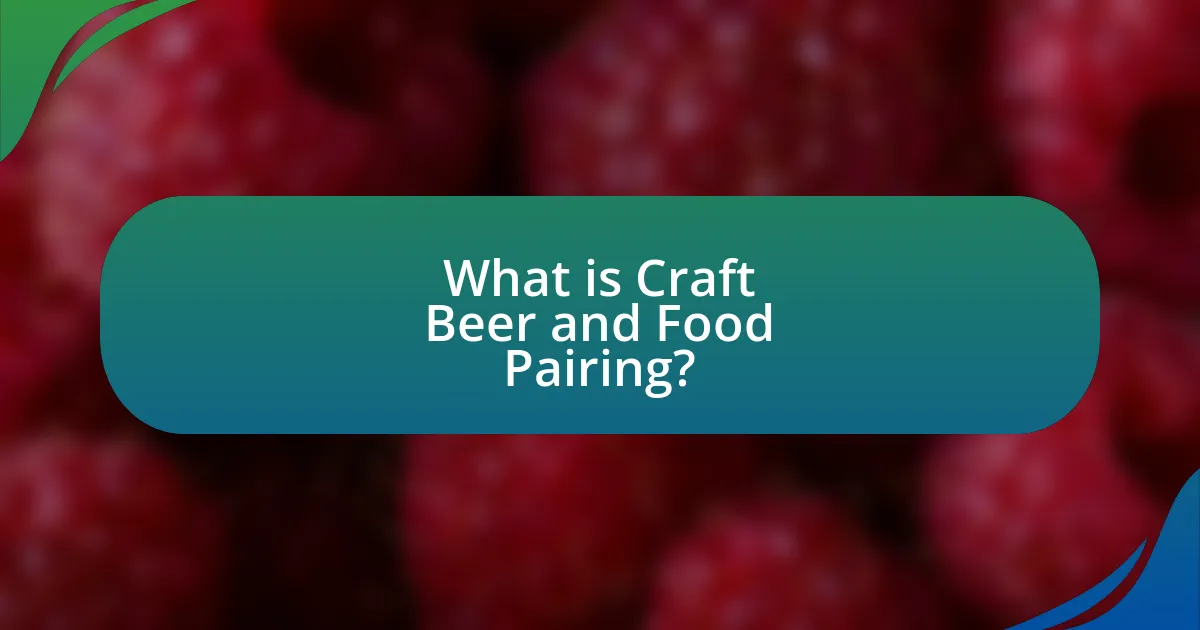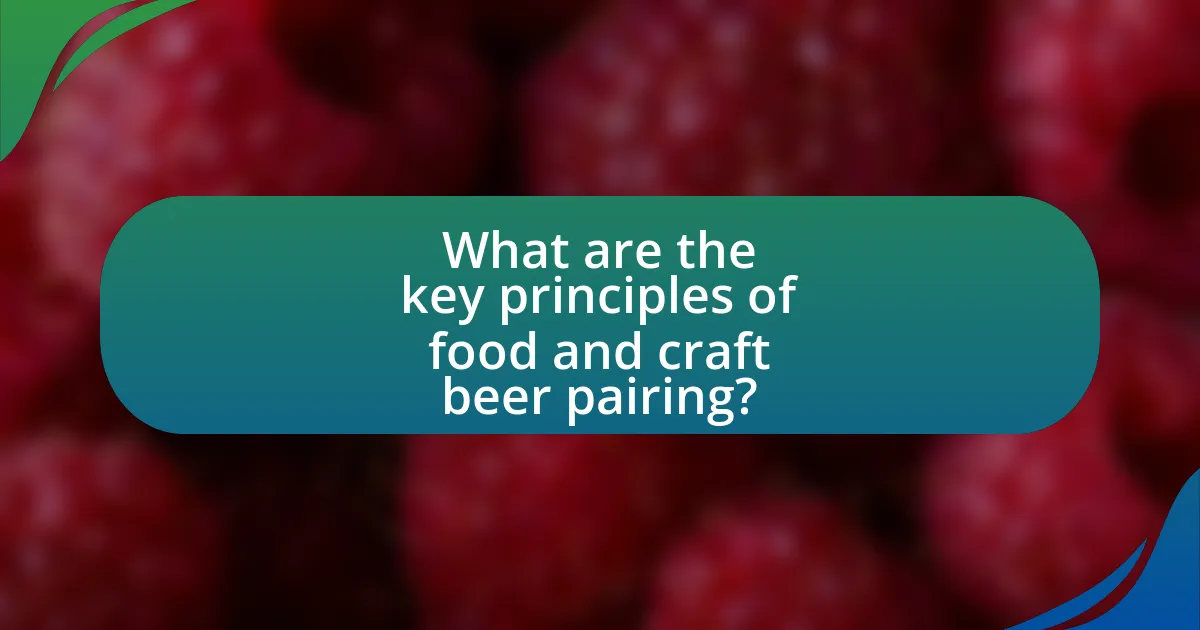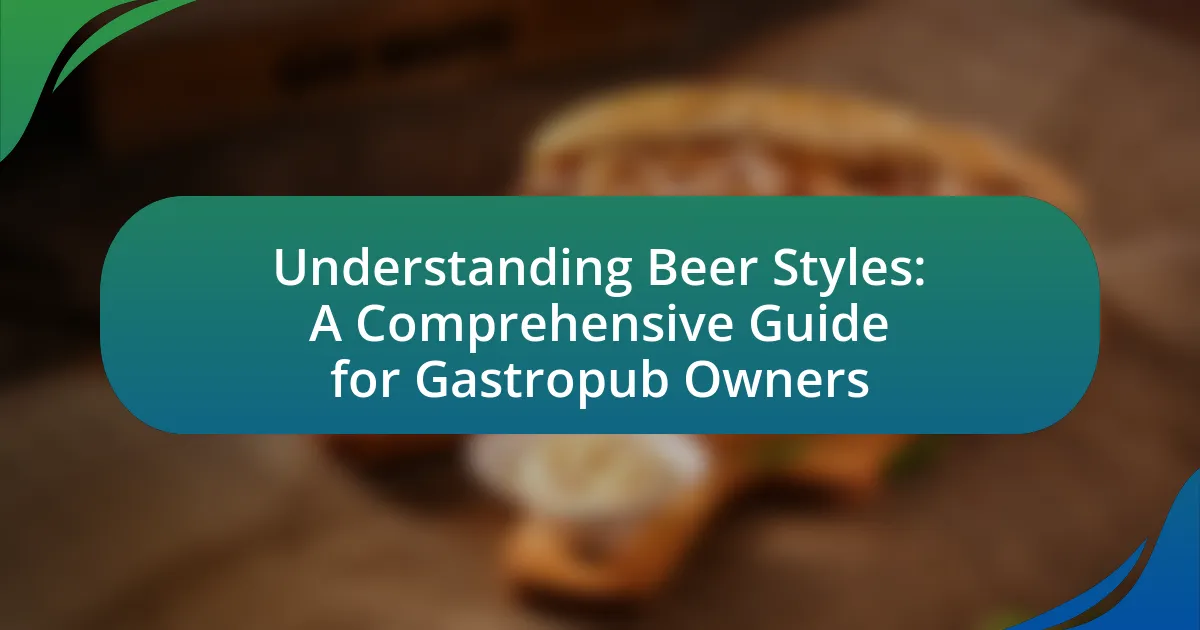Craft beer and food pairing is the practice of selecting specific craft beers to enhance the flavors of various dishes, focusing on the unique characteristics of different beer styles. This article explores how craft beer can elevate the dining experience by complementing and contrasting with food flavors, emphasizing the importance of matching intensity and considering texture. It also highlights key principles of successful pairings, common mistakes to avoid, and insights from top gastropub chefs on creating harmonious flavor experiences. Additionally, practical tips for home cooks and best practices for experimentation are provided to help individuals develop their palate and enhance their culinary experiences.

What is Craft Beer and Food Pairing?
Craft beer and food pairing is the practice of selecting specific craft beers to complement and enhance the flavors of various dishes. This pairing is based on the unique characteristics of craft beers, such as their aroma, bitterness, and sweetness, which can either contrast with or complement the flavors of food. For example, a hoppy IPA can balance the richness of a fatty dish, while a malty stout may enhance the sweetness of a dessert. The goal of this pairing is to create a harmonious dining experience that elevates both the beer and the food.
How does craft beer enhance the dining experience?
Craft beer enhances the dining experience by providing unique flavors that complement and elevate food pairings. The diverse range of craft beer styles, such as IPAs, stouts, and sours, allows for tailored pairings that can enhance the taste profiles of various dishes. For instance, a hoppy IPA can cut through the richness of a fatty dish, while a fruity sour can balance the acidity of a salad. Studies have shown that specific beer and food pairings can enhance the overall sensory experience, making meals more enjoyable and memorable.
What flavors in craft beer complement specific foods?
Hoppy flavors in craft beer, such as those found in IPAs, complement spicy foods by balancing heat with bitterness. Malty flavors, typical in stouts and porters, pair well with rich, savory dishes like barbecue, enhancing the umami profile. Citrusy notes in wheat beers enhance seafood dishes, while fruity flavors in sour ales can elevate desserts, creating a harmonious balance. These pairings are supported by culinary principles that emphasize contrasting and complementary flavors, ensuring a well-rounded dining experience.
How does the brewing process influence flavor profiles?
The brewing process significantly influences flavor profiles by determining the extraction of various compounds from ingredients like malt, hops, and yeast. During mashing, enzymes convert starches into sugars, which affects sweetness and body; the type of malt used contributes caramel, chocolate, or roasted flavors. Hops added during boiling impart bitterness, aroma, and flavor, with different hop varieties offering distinct profiles such as citrus, floral, or pine notes. Fermentation, driven by yeast, produces alcohol and various esters and phenols, which can add fruity or spicy characteristics. For example, a study published in the Journal of the American Society of Brewing Chemists highlights that fermentation temperature can alter the production of these flavor compounds, thus impacting the final taste of the beer.
Why is food pairing important in gastropubs?
Food pairing is important in gastropubs because it enhances the overall dining experience by complementing flavors and textures between food and craft beer. This synergy not only elevates the taste of both the food and the beverage but also encourages patrons to explore new combinations, leading to increased customer satisfaction and repeat visits. Research indicates that well-paired food and drink can significantly enhance flavor perception, making the meal more enjoyable and memorable for guests.
What role does food pairing play in customer satisfaction?
Food pairing significantly enhances customer satisfaction by creating harmonious flavor experiences that elevate the overall dining experience. When food and craft beer are thoughtfully paired, they can complement and enhance each other’s flavors, leading to a more enjoyable meal. Research indicates that well-executed food pairings can increase perceived value and satisfaction, as customers often seek unique and memorable culinary experiences. For instance, a study published in the Journal of Culinary Science & Technology found that diners reported higher satisfaction levels when their meals were paired with appropriate beverages, highlighting the importance of synergy in flavor profiles.
How can food pairing elevate the perception of craft beer?
Food pairing can elevate the perception of craft beer by enhancing its flavors and creating a more enjoyable tasting experience. When specific foods are matched with craft beers, the complementary flavors can highlight the beer’s unique characteristics, making it more appealing to consumers. For instance, a hoppy IPA can be paired with spicy dishes to balance the bitterness, while a rich stout may be complemented by chocolate desserts, enhancing both the beer and the food. This intentional pairing not only showcases the versatility of craft beer but also encourages consumers to explore and appreciate its complexity, ultimately leading to a greater appreciation for the craft brewing process.

What are the key principles of food and craft beer pairing?
The key principles of food and craft beer pairing include complementing flavors, balancing intensity, and considering texture. Complementing flavors involves matching the taste profiles of the food and beer, such as pairing citrusy IPAs with spicy dishes to enhance the overall experience. Balancing intensity means aligning the strength of the beer with the richness of the food; for example, a robust stout can stand up to hearty meats. Considering texture is also crucial, as the carbonation in beer can cut through creamy or fatty foods, creating a harmonious mouthfeel. These principles are supported by culinary experts who emphasize that successful pairings enhance both the food and the beer, leading to a more enjoyable dining experience.
How do flavors interact between food and craft beer?
Flavors interact between food and craft beer through complementary and contrasting profiles that enhance the overall tasting experience. Complementary pairings, such as a citrusy IPA with spicy dishes, highlight similar flavor notes, while contrasting pairings, like a rich stout with a sweet dessert, create balance by offsetting flavors. Research indicates that the carbonation in beer can cleanse the palate, making it easier to appreciate the nuances of both the food and the beer. This interaction is essential in gastropub settings, where chefs curate pairings to elevate the dining experience, demonstrating that thoughtful combinations can lead to a more enjoyable meal.
What are the basic flavor profiles to consider?
The basic flavor profiles to consider are sweet, sour, salty, bitter, and umami. These profiles serve as fundamental building blocks in culinary applications, influencing how food and beverages, such as craft beer, are paired. For instance, sweet flavors can balance bitterness in beer, while sour notes can enhance the freshness of certain dishes. Understanding these profiles allows chefs to create harmonious pairings that elevate the dining experience.
How can contrasting flavors create a balanced pairing?
Contrasting flavors create a balanced pairing by enhancing each other’s characteristics, leading to a more complex and enjoyable tasting experience. For instance, the bitterness of a hoppy IPA can be complemented by the sweetness of a caramelized dish, allowing the flavors to stand out without overwhelming the palate. This principle is supported by the concept of flavor synergy, where different taste profiles interact to create a harmonious balance, as seen in culinary practices that emphasize the pairing of sweet and savory elements.
What are common mistakes in craft beer and food pairing?
Common mistakes in craft beer and food pairing include ignoring complementary flavors, mismatching intensity, and overlooking carbonation effects. Ignoring complementary flavors can lead to clashes, such as pairing a bitter IPA with a delicate fish dish, which can overwhelm the food’s subtle taste. Mismatching intensity occurs when a light lager is served with a rich, hearty meal, resulting in the beer being overshadowed. Additionally, overlooking carbonation effects can result in a poor pairing, as high carbonation can enhance or detract from the food’s texture and flavor, such as pairing a highly carbonated beer with creamy dishes, which can disrupt the mouthfeel.
How can overbearing flavors ruin a pairing?
Overbearing flavors can ruin a pairing by overwhelming the palate and masking the subtleties of both the food and the beverage. When a dish or drink has dominant flavors, such as excessive spice or sweetness, it can overshadow complementary elements, leading to a disjointed tasting experience. For instance, a heavily hopped IPA may clash with a delicate seafood dish, making it difficult to appreciate the nuances of either. This imbalance can result in a lack of harmony, where neither the food nor the beer is enjoyed to its fullest potential.
What should be avoided when selecting beer for a dish?
When selecting beer for a dish, one should avoid pairing overly bitter or hoppy beers with delicate flavors. Such beers can overpower the dish, masking its subtle nuances. For instance, pairing a highly hopped IPA with a light seafood dish can lead to an unbalanced flavor profile, as the bitterness of the beer may dominate the palate. This principle is supported by the concept of flavor harmony in culinary practices, which emphasizes the importance of matching the intensity of flavors in food and drink.

What insights do top gastropub chefs offer on pairing?
Top gastropub chefs emphasize the importance of balancing flavors when pairing food with craft beer. They recommend matching the intensity of the dish with the beer, ensuring that neither overpowers the other. For instance, rich, hearty dishes pair well with robust stouts or IPAs, while lighter fare complements pilsners or wheat beers. Additionally, chefs suggest considering the beer’s carbonation, which can enhance the texture of the food, and the beer’s bitterness, which can cut through fatty or rich flavors. These insights are grounded in the principle that successful pairings enhance the overall dining experience by creating harmony between the food and beverage.
What are the favorite pairings of renowned gastropub chefs?
Renowned gastropub chefs favor pairings that enhance both the food and the craft beer experience. Common pairings include rich, malty beers with hearty dishes like beef stew, while hoppy IPAs often complement spicy foods such as buffalo wings. For example, chefs frequently recommend pairing a stout with chocolate desserts, as the beer’s roasted flavors enhance the sweetness of the chocolate. These pairings are based on the principle that the flavors in the beer can either contrast or complement the dish, creating a balanced dining experience.
How do chefs choose craft beers for their menus?
Chefs choose craft beers for their menus by considering flavor profiles, food pairings, and local availability. They analyze the taste characteristics of the beers, such as bitterness, sweetness, and aroma, to ensure they complement the dishes served. For instance, a hoppy IPA may pair well with spicy foods, while a rich stout can enhance chocolate desserts. Additionally, chefs often prioritize sourcing beers from local breweries to support the community and provide unique offerings that reflect regional tastes. This approach not only enhances the dining experience but also aligns with trends in craft beer consumption, where 60% of consumers prefer local products.
What unique pairings have gained popularity in gastropubs?
Unique pairings that have gained popularity in gastropubs include craft beer with gourmet burgers, artisanal cheeses with sour ales, and spicy dishes paired with IPAs. These combinations enhance the dining experience by complementing flavors; for instance, the richness of a gourmet burger is balanced by the hoppy bitterness of an IPA, while the acidity of sour ales cuts through the creaminess of artisanal cheeses. This trend reflects a broader movement towards elevated comfort food and craft beverage pairings, as evidenced by the increasing number of gastropubs focusing on curated menus that highlight these unique combinations.
How can home cooks apply chef tips for better pairings?
Home cooks can apply chef tips for better pairings by understanding the flavor profiles of both food and craft beer. Chefs recommend matching the intensity of flavors; for example, rich, hearty dishes pair well with robust beers like stouts, while lighter fare complements crisp lagers. Additionally, chefs suggest considering complementary and contrasting flavors; citrusy beers can enhance seafood, while malty beers can balance spicy dishes. This approach is supported by the principle that similar flavor compounds enhance the overall tasting experience, as seen in studies on flavor pairing.
What practical steps can be taken to experiment with pairings?
To experiment with pairings, start by selecting a variety of craft beers and complementary foods. Begin with contrasting flavors, such as pairing a hoppy IPA with spicy dishes, which enhances the beer’s bitterness while balancing the heat. Next, try matching similar flavor profiles, like a malty stout with chocolate desserts, to create harmony. Document each pairing’s taste experience to identify successful combinations. Additionally, consider hosting tasting events with friends to gather diverse opinions and insights on the pairings. This method is supported by the practice of sensory evaluation, which shows that collaborative tasting can enhance understanding of flavor interactions.
How can one develop a personal palate for craft beer and food?
To develop a personal palate for craft beer and food, one should engage in systematic tasting and exploration of various styles and pairings. This involves sampling different craft beers, such as IPAs, stouts, and lagers, alongside a diverse range of foods, including cheeses, meats, and vegetables, to identify flavor profiles that resonate personally. Research indicates that repeated exposure to different flavors enhances sensory perception and preference development, as noted in studies on flavor learning by researchers like Spence and Piqueras-Fiszman. By keeping a tasting journal to document experiences and preferences, individuals can refine their palate over time, leading to a more informed and enjoyable craft beer and food pairing experience.
What are the best practices for successful craft beer and food pairing?
Successful craft beer and food pairing involves matching the flavors and characteristics of the beer with the dish to enhance the overall dining experience. To achieve this, consider the following best practices:
-
Complementary Flavors: Pair beers with food that have similar flavor profiles. For example, a hoppy IPA can enhance spicy dishes, while a malty stout can complement chocolate desserts.
-
Contrast: Use contrasting flavors to create balance. A sour beer can cut through the richness of fatty foods, while a crisp lager can refresh the palate after a heavy meal.
-
Intensity Matching: Match the intensity of the beer with the dish. Light beers work well with lighter fare, such as salads or seafood, while robust beers pair better with hearty meats or rich sauces.
-
Regional Pairing: Consider pairing local beers with regional dishes, as they often share complementary flavors. For instance, a Belgian ale can enhance the flavors of a traditional Belgian dish.
-
Experimentation: Encourage trying different combinations to discover unique pairings, as personal preferences play a significant role in what works best.
These practices are supported by culinary experts who emphasize the importance of flavor harmony and balance in creating memorable dining experiences.




